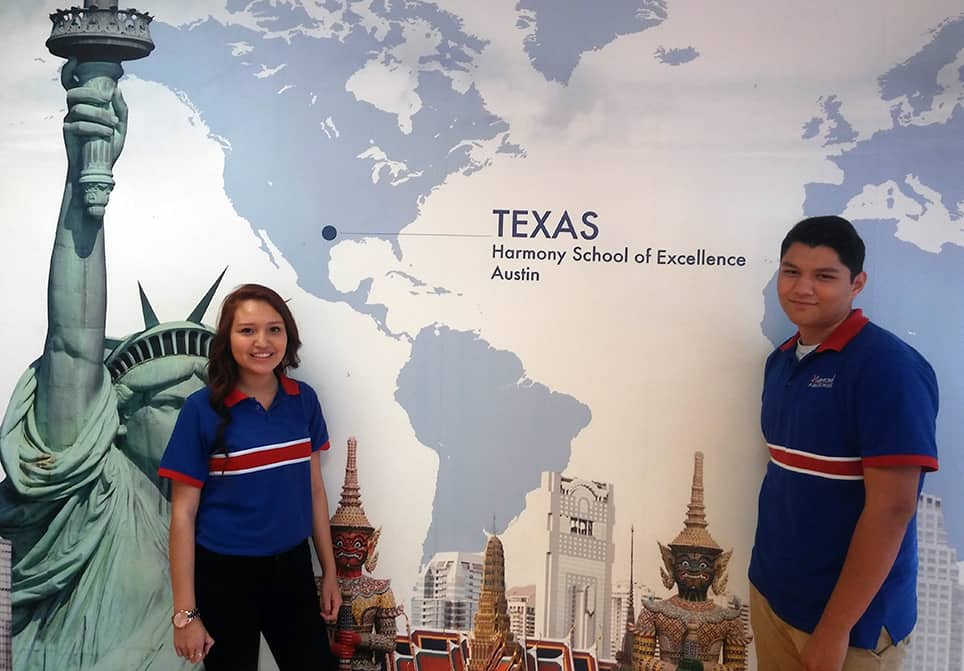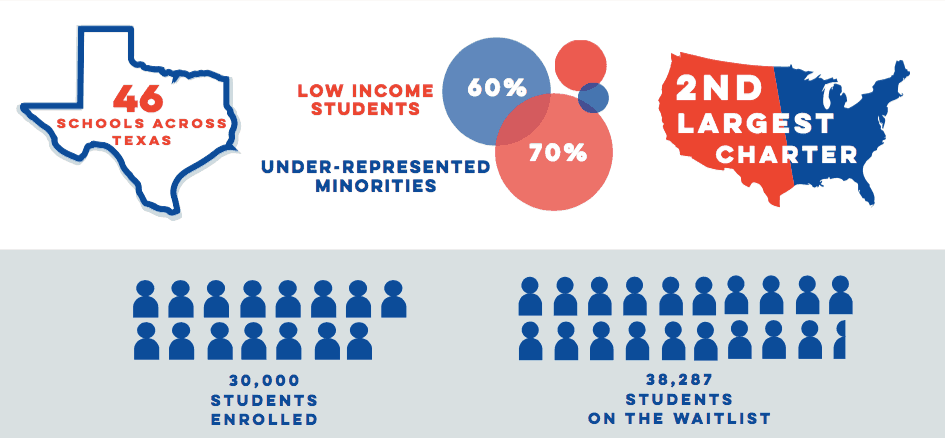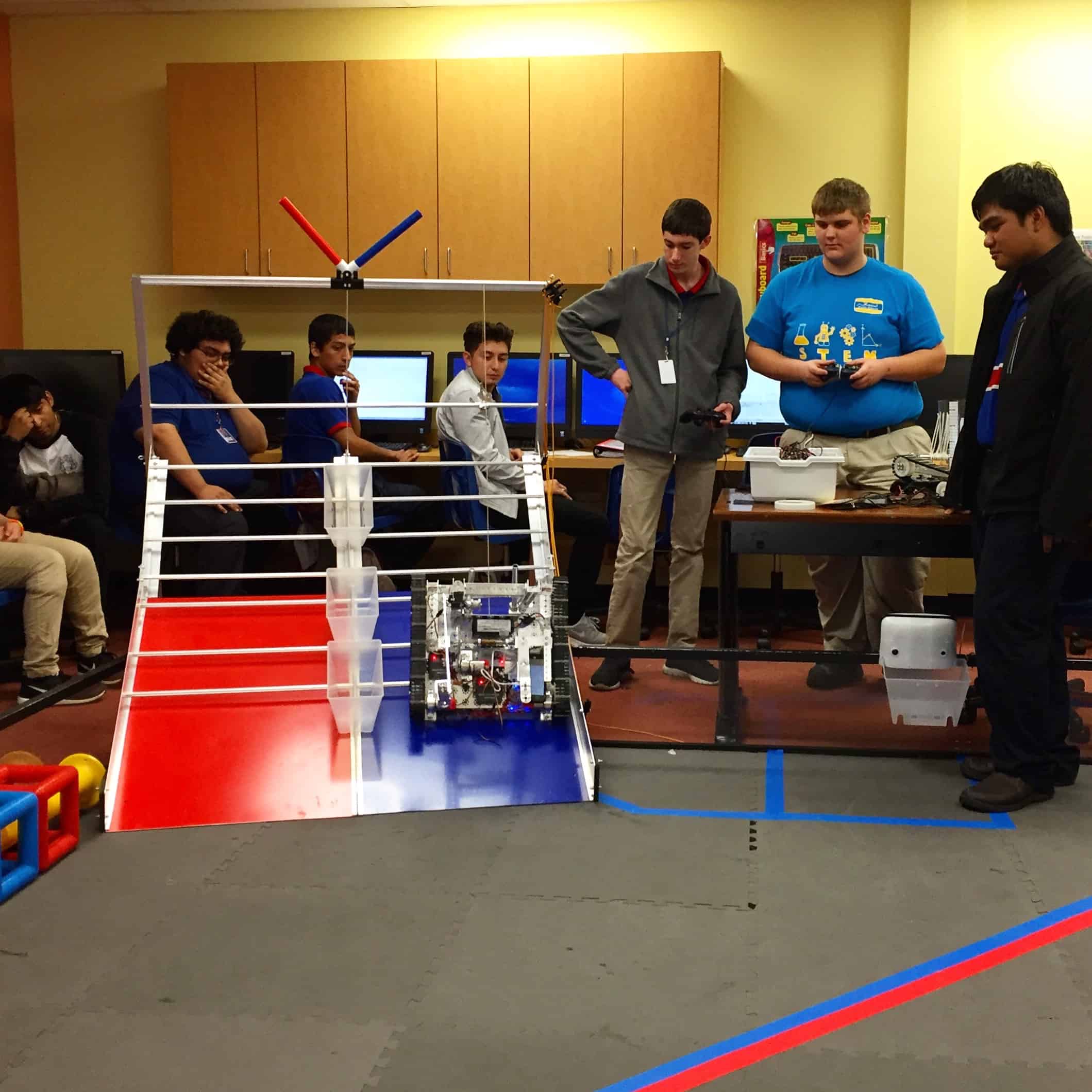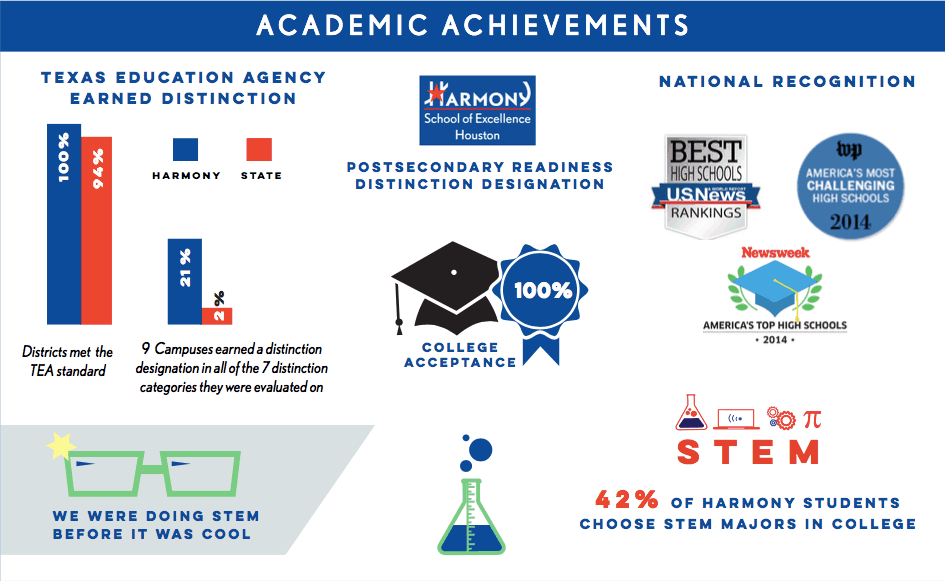Learner-Centered STEM: Meet Harmony Public Schools

What do you get when you mix STEM, project-based learning, college prep, personalized blended learning, and a small supportive environment? You get the largest high performing school network you’ve probably never heard of–Harmony Public Schools.
The first Harmony school opened in Houston in 2000 with 200 students. The network started with grades 6-12 and added elementary schools in 2005. Now, 46 schools serve over 30,000 students (and even more than that on the waiting list).
Last week, I visited Harmony School of Excellence in Austin, a 6-12 school opened in 2009 in a south Austin business park. The converted office warehouse is a welcoming space that serves mostly low-income Hispanic students. Like the two tour guides pictured above, my tour was led by two capable students – Abraham Medrano (sophomore) and Zakya Anwar (senior). The lobby is filled with pictures of graduates that have all gone on to college. The student-centered, project-based, STEM-focused school is an example of what has become one of the largest and highest performing in the country. The visit inspired us to launch a series, “Getting Smart on Learner-Centered STEM.”

Core Values in Action. Harmony’s core values–high expectations, dedicated staff, working together, character matters and STEM for all–were obvious in classrooms and school culture. Harmony has created a high press, high support environment. There’s a strong community feel where rigor, relevance and relationships are clearly emphasized. Students are provided with a good balance of support and independence.
The college-going culture is reinforced by policies, practices and supports. College acceptance and college credit (AP or dual enrollment) are graduation requirements. College planning starts in 8th grade with a high school plan. Harmony School of Excellence in Austin currently offers 9 AP courses, and several Harmony schools offer double that. College visits start in 9th grade with at least two per year in grades 10, 11 and 12. Students meet with an advisor daily and a counsellor on a regular basis. My student tour guides said the advisors and counsellors were very helpful in identifying and applying to colleges (echoing our thoughts on the role of advisory in personalized learning).
Learner-Centered STEM. Harmony developed its own STEM curriculum–STEM Students on the Stage (STEM SOSTM). Funded through a federal Race to the Top-District grant, the model incorporates hands-on project-based and inquiry-based learning with the goal of not only increasing students’ STEM knowledge and interest, but also producing self- motivated and self-regulated learners. (See the Rtt-D feature on Harmony’s plan here.) Physics labs feature 3D printers, Other Mill and resin printer. A guide showed me how he uses Tinkercad to design parts.

Harmony recruits talented teachers including some with international experience. Many have advanced degrees, all have strong content expertise. My tour guides said, “We have lots of opportunity to meet with our teachers including Saturday morning tutoring.” They added, “This is a small community; all teachers know me.”
Every Harmony secondary school has a First Robotics team. Last year eight Harmony teams made it to the world championships. The robot below featured a grappling hook and winch for scaling the wall.

Central to STEM SOS is the Buck Institute Gold Standard approach to project-based learning. It starts in elementary school and is supported by a PBL platform. Students progress from short term applications, to interdisciplinary STEM projects, and year long student-driven explorations.
Testing Gallium’s melting point @STEMSOS @tvanderark pic.twitter.com/qhLRq07FVu
— Harmony Austin (@hpsaustin) January 25, 2016
Early Boost. In 2003, Texas Gov. Perry was frustrated after a meeting with business leaders. He asked how they could boost youth employability especially in STEM fields. I suggested a network of STEM and Early College high schools. The Texas High School Project (THSP), now Educate Texas, was born with an initial goal of developing 15 Early College and 35 STEM schools and improving dozens of struggling high schools.
Ten years later THSP proved to be one of the most productive public-private partnerships in the country with 135 new ECHS and T-STEM academies serving more than 63,000 students–-with more than 75% historically underrepresented and economically disadvantaged learners. Results have been impressive with high achievement, graduation, advanced placement, college attendance and college persistence rates.
With three schools and a proven model in 2004, the Harmony network was well positioned to take advantage of THSP resources, and continues to earn the respect and praises of Educate Texas leaders like Executive Director John Fitzpatrick.
“Harmony is a great statewide public charter school success story in Texas. We love their model of rigorous academic coursework, project based learning and an emphasis on engaging extracurricular activities like robotics competitions and science olympiads,” says Fitzpatrick. “Educate Texas is proud to have been an early supporter and funder of Harmony Public Schools and their visionary leader Soner Tarim.”
Results and recognition. Texas boasts the country’s 2nd highest cohort graduate rate, and Harmony Public Schools exceed the state average. In addition, Harmony has a 100 percent college acceptance rate and nearly half of Harmony students go on to STEM majors in college. We’re looking forward to learning more about Harmony so we can share what it takes to get results like theirs. Early observations indicate it’s the combination of strong, entrepreneurial leaders, a thoughtful and deliberate approach to cultivating and recruiting top talent, a creative and resourceful approaches to combining modular components and a real commitment to creating a culture that supports all of the above.

Together with Harmony educators, we’ll explore the theme of Learner-Centered STEM by unpacking the Harmony STEM SOS model, sharing more about the school culture required to support this model and highlighting what personalized, project-based learning looks like for students and teachers.
What would you like to learn more about as we explore Learner-Centered STEM? Tell us in the comments or tweet us using @Getting_Smart and #STEMSOS.
This post is a part of a blog series in the upcoming “Getting Smart on Learner-Centered STEM” Smart Bundle produced in partnership with Harmony Public Schools (@HarmonyEDU). Join the conversation on Twitter using #STEMSOS.
For more on these topics, see:
- How Robotics is Transforming STEM in Elementary Schools
- 5 Ways Parents Can Support STEM Learning
- Smart List: 34 STEM Networks & Maker Resources
- Exposing Every Student to STEM
Stay in-the-know with all things EdTech and innovations in learning by signing up to receive the weekly Smart Update. This post includes mentions of a Getting Smart partner. For a full list of partners, affiliate organizations and all other disclosures please see our Partner page.





Iris Wamalwa Naka
I am a Proud and honored educator, and a member of the Harmony family. I am an active element member of our school and community to empower and guide the impressionable students our future leaders!
Mehmet
Core Values in Action. Harmony’s core values–high expectations, dedicated staff, working together, character matters and STEM for all–were obvious in classrooms and school culture. Harmony has created a high press, high support environment. There’s a strong community feel where rigor, relevance and relationships are clearly emphasized. Students are provided with a good balance of support and independence.
Well said!
Vehbi Sonmez
STEM is a critical focus area for Harmony Public Schools.I strongly believe that Our future success and our nation's technological advancement depend on highly well organized STEM program, STEM SOS, which you can find in Harmony Public Schools.As a STEM educator, I am proud to be part of STEM SOS model and Harmony Public Schools.
Richard Ray
Such a wonderful program. It is inspiring to see these young minds thriving in that school environment. Thanks for this article Tom.
Gercek
Nice to read a meticulously written, pretty lucidly explained and quite insightful article regarding STEM Education. Just one tiny disagreement, if I may:
"You get the largest high performing school network you’ve probably never heard of–Harmony Public Schools."
I believe all curious educators over the world are well aware of this continuously booming STEM model, from America to China...
Thanks for this great article. I am looking forward to reading your next work on STEM education.